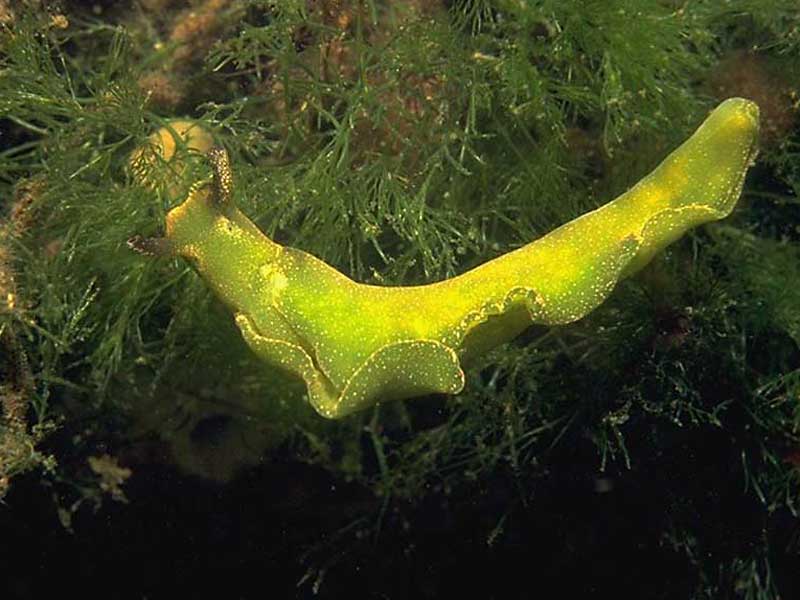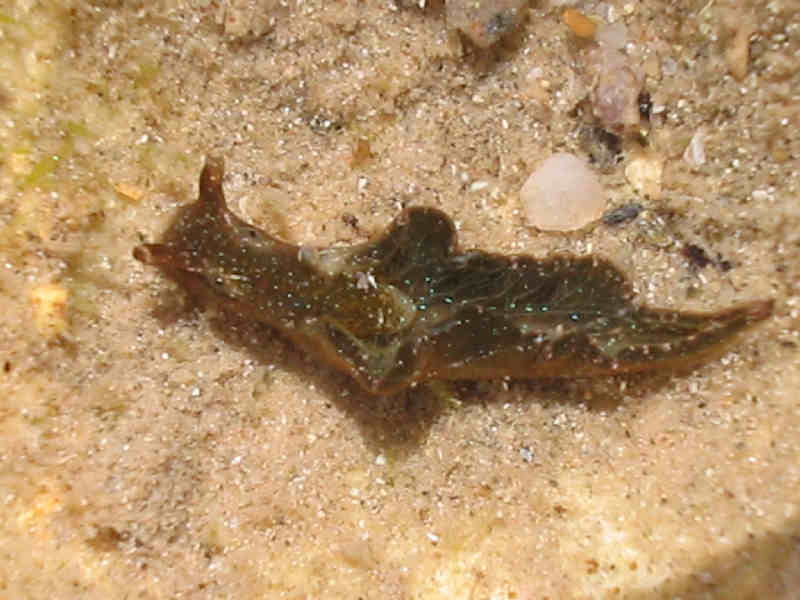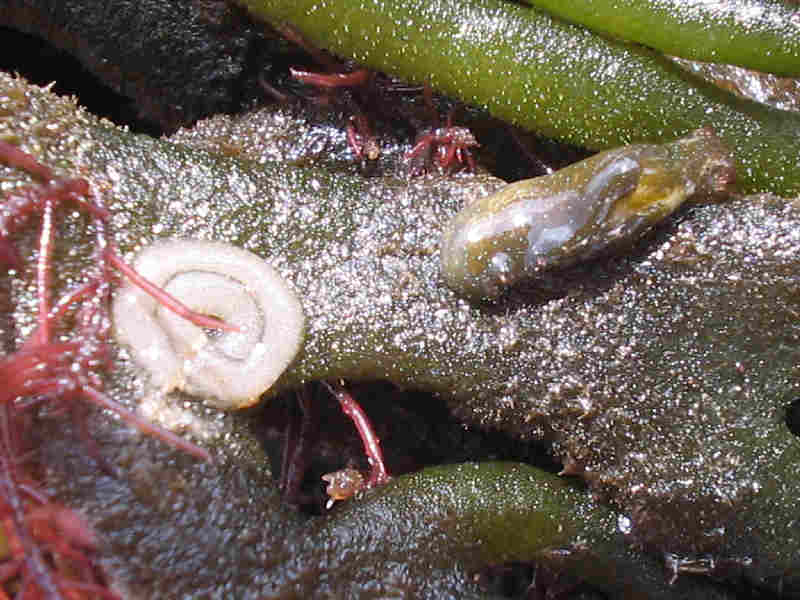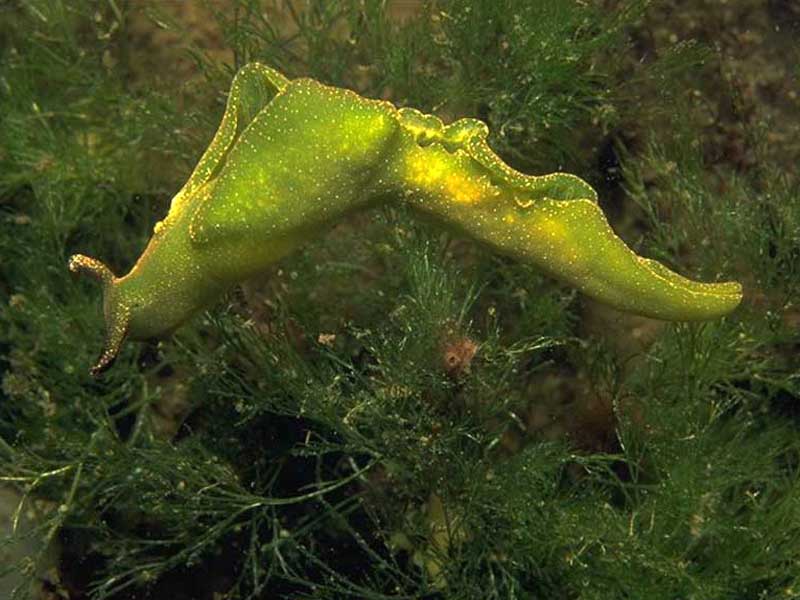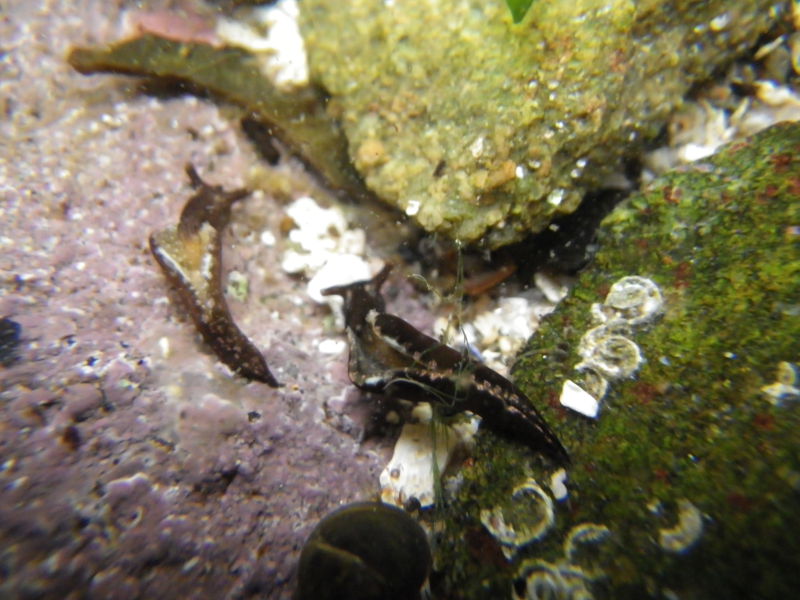Solar-powered sea slug (Elysia viridis)
Distribution data supplied by the Ocean Biodiversity Information System (OBIS). To interrogate UK data visit the NBN Atlas.Map Help
| Researched by | Sonia Rowley | Refereed by | Admin |
| Authority | (Montagu, 1804) | ||
| Other common names | - | Synonyms | - |
Summary
Description
Recorded distribution in Britain and Ireland
This species probably distributed throughout the British Isles, although most records are from the western coats.Global distribution
-Habitat
This species can be found on the underside of macroalgal fronds in shallow water and rock pools. Elysia viridis feeds usually on Codium sp. or Cladophora sp. in European waters.Depth range
-Identifying features
- Body up to 5 cm long.
- Commonly vivid green, occasionally bright red or brown.
- Tiny glistening red, blue or green spots.
- Enrolled rhinophores.
- Parapodia broad and extends most of body length.
- Lateral parapodial 'wings' outstretched or folded over dorsum.
Additional information
Elysia viridis is very similar to the sea hare in its soft winged body and colouration, although Elysia sp. is flatter with no oral tentacles. Elysia viridis is known as a 'sap-sucking slug' and feeds only on a single or limited food source (stenophagous). It ingests the chloroplasts unharmed and uses them for photosynthesis which benefit the slugs food supply (a process known as klepoplasty). Chloroplasts account for the colouration of the animal.This species has a 12-15 month life-span and is sexually mature when 1.2 cm in length. It produces benthic egg masses from April to October which hatch as planktonic veligers. This species may also tolerate low salinity levels.
Listed by
- none -
Bibliography
Allen, J.A. 1962. The fauna of the Clyde Sea area. Mollusca. Millport: Scottish Marine Biological Association.
Bruce, J.R., Colman, J.S. & Jones, N.S., 1963. Marine fauna of the Isle of Man. Liverpool: Liverpool University Press.
Crothers, J.H. (ed.), 1966. Dale Fort Marine Fauna. London: Field Studies Council.
Dipper, R., & Powell. A., 1984. Field guide to the water life of Britain. London: Reader's Digest Association Limited.
Hayward, P., Nelson-Smith, T. & Shields, C. 1996. Collins pocket guide. Sea shore of Britain and northern Europe. London: HarperCollins.
Hayward, P.J. & Ryland, J.S. (ed.) 1995b. Handbook of the marine fauna of North-West Europe. Oxford: Oxford University Press.
Howson, C.M. & Picton, B.E., 1997. The species directory of the marine fauna and flora of the British Isles and surrounding seas. Belfast: Ulster Museum. [Ulster Museum publication, no. 276.]
Jensen, K.R., 1989. Learning as a factor in diet selection by Elysia viridis (Montagu) (Opisthobranchia). Journal of Molluscan Studies, 55, 79-88.
JNCC (Joint Nature Conservation Committee), 1999. Marine Environment Resource Mapping And Information Database (MERMAID): Marine Nature Conservation Review Survey Database. [on-line] http://www.jncc.gov.uk/mermaid
Thompson, T. E. & Brown, G. H., 1976. British Opisthobranch Molluscs. London: Academic Press. [Synopses of the British Fauna, no. 8.]
Trowbridge, C.D., 2000. The missing links: larval and post-larval development of the ascoglossan opisthobranch Elysia viridis. Journal of the Marine Biological Association of the United Kingdom, 80(6), 1087-1094.
Datasets
Centre for Environmental Data and Recording, 2018. Ulster Museum Marine Surveys of Northern Ireland Coastal Waters. Occurrence dataset https://www.nmni.com/CEDaR/CEDaR-Centre-for-Environmental-Data-and-Recording.aspx accessed via NBNAtlas.org on 2018-09-25.
Conchological Society of Great Britain & Ireland, 2018. Mollusc (marine) data for Great Britain and Ireland - restricted access. Occurrence dataset: https://doi.org/10.15468/4bsawx accessed via GBIF.org on 2018-09-25.
Conchological Society of Great Britain & Ireland, 2023. Mollusc (marine) records for Great Britain and Ireland. Occurrence dataset: https://doi.org/10.15468/aurwcz accessed via GBIF.org on 2024-09-27.
Fenwick, 2018. Aphotomarine. Occurrence dataset http://www.aphotomarine.com/index.html Accessed via NBNAtlas.org on 2018-10-01
Kent Wildlife Trust, 2018. Kent Wildlife Trust Shoresearch Intertidal Survey 2004 onwards. Occurrence dataset: https://www.kentwildlifetrust.org.uk/ accessed via NBNAtlas.org on 2018-10-01.
NBN (National Biodiversity Network) Atlas. Available from: https://www.nbnatlas.org.
OBIS (Ocean Biodiversity Information System), 2025. Global map of species distribution using gridded data. Available from: Ocean Biogeographic Information System. www.iobis.org. Accessed: 2025-01-06
Citation
This review can be cited as:
Last Updated: 19/09/2006

